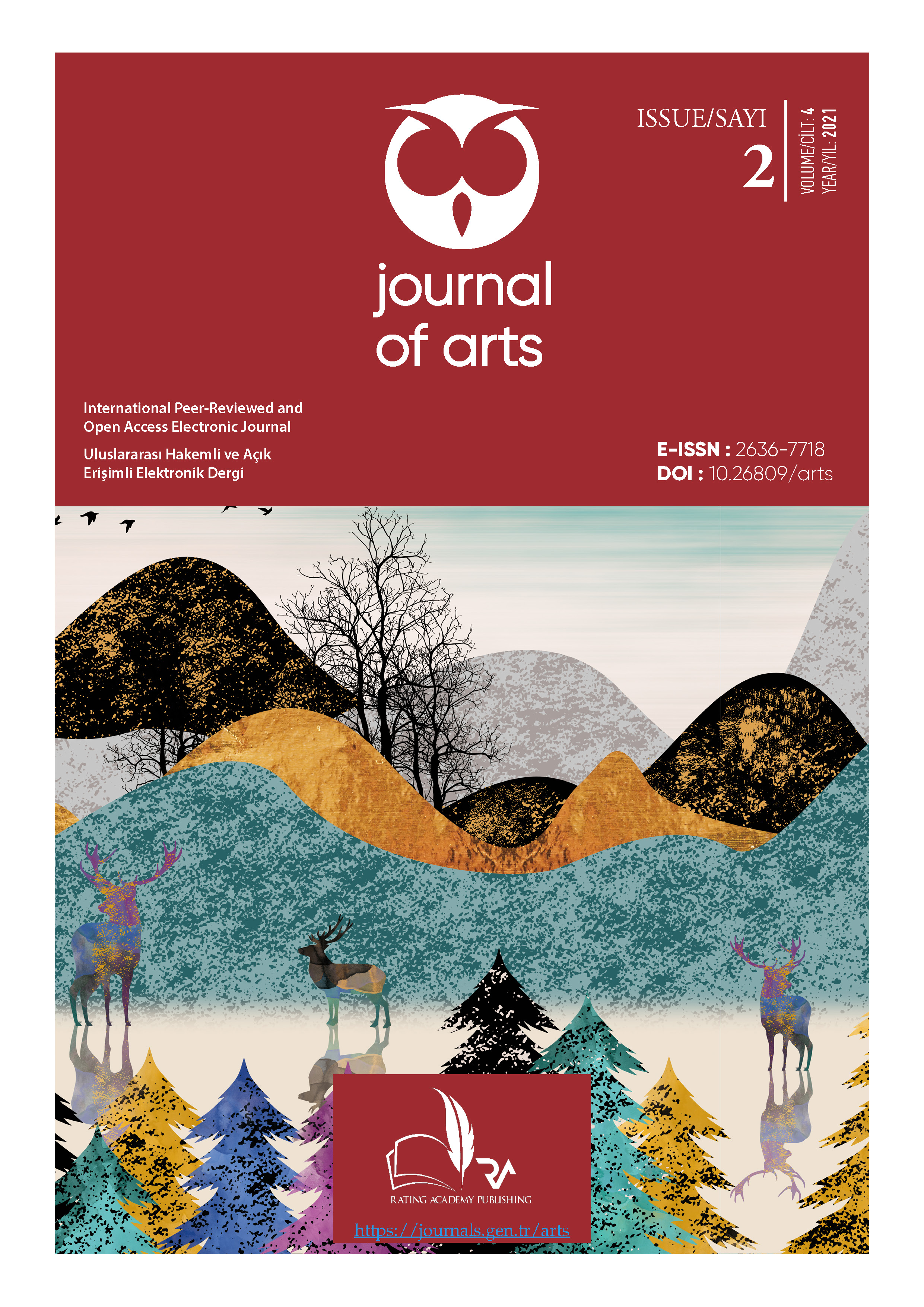Abstract
The use of ceramics has been around for thousands of years as a part of human culture. Color is a cultural element almost as old as the use of ceramics. Red is probably the first color to be used consciously on ceramics. The strong symbolic significance of this color can be seen in thousands of years of cave paintings and its use in different cultural fields.
In the research, it has been determined that while humanity is trying to reach the red color, the main color, red, also includes intermediate tones such as orange, brown, pink, burgundy, purple, etc. Within the scope of the research, while explaining the ways to reach the red color, in addition to the main color red, the accent colors and semitones of red were also included.
Based on the question of why mankind uses the color red in ceramic making, what cultural meanings he attributes to this color and the symbolic language in the use of color are examined. Then the question “how is this color obtained, in other words, what is the technology?” has been asked. Information was given about the material properties that enabled the color to emerge, the different technological stages observed in the historical process and the techniques used for obtaining the color.
Accordingly, different techniques such as clay coloring, surface coloring, glaze and alternative firing in ceramics are explained.
References
ARCASOY, A. ve BAŞKIRKAN H. (2020). Seramik Teknolojisi. Literatür Yayıncılık, İstanbul.
BALYEMEZ, A. (2018), Gösterişli Bir Uzakdoğu Porselen Stili: Kinrande, İdil Sanat ve Dil Dergisi, Cilt 7, Sayı 47, sayfa 817-822.
BERLIN, B., ve KAY, P. (1969). Basic Color Terms: Their Universality and Evolution. Berkeley.
BÜYÜK LAROUSSE SÖZLÜK VE ANSİKLOPEDİSİ, Librairie Larousse, Milliyet, 1986.
ÇİZER S. ve YOLERİ H. (1998). Geleneksel Macun Lüsterleri Tekniğinin Günümüzde Uygulama Denemeleri. Seramik Sırları ve Boyaları Semineri Bildiriler Kitapçığı, TSD Yayınları No: 18, İstanbul.
ÇİZER, S. (2014). Terra Sigillata. Dokuz Eylül Üniversitesi Güzel Sanatlar Fakültesi Yayınları, İzmir.
ÇOBANLI, Z. (1996). Seramik Astarları. Anadolu Üniversitesi GSF Yayınları, No: 15, Eskişehir.
ÇOBANOĞLU, Ö. (2012). Türk Mitolojisinde Al Dini ve Okra İlişkisi, 38. ICANAS Uluslararası Asya ve Kuzey Afrika Çalışmaları Kongresi: Tarih ve Medeniyetler Tarihi, s.981-986. https://www.ayk.gov.tr/wp-content/uploads/2015/01/%c3%87OBANO%c4%9eLU-%c3%96zkul-T%c3%9cRK-M%c4%b0TOLOJ%c4%b0S%c4%b0NDE-AL-D%c4%b0N%c4%b0-VE-OKRA-%c4%b0L%c4%b0%c5%9eK%c4%b0S%c4%b0.pdf (Erişim tarihi: 16.02.2021)
ECZACIBAŞI SANAT ANSİKLOPEDİSİ (1997). 2. Cilt, 3/1657, YEM Yayınları, İstanbul.
EKİCİ, M. (2016). Türk Kültüründe "Al" Renk. Ege Üniversitesi Türk Dünyası İncelemeleri Dergisi, Cilt 16 (2), s. 103, 104. https://www.researchgate.net/publication/311851360_Turk_Kulturunde_Al_Renk (Erişim tarihi: 15.02.2021)
ERDOĞU, B., ve ULUBEY, A. (2011). Colour Symbolism in the Prehistoric Architecture of Central Anatolia and Raman Spectroscopic Investigation of Red Ochre in Chalcolithic Çatalhöyük. Oxford Journal of Archeology, Cilt 30, s. 1-11.
ESTES, C. P. (2014). Kurtlarla Koşan Kadınlar. Çeviren: H. Atalay, İstanbul, Ayrıntı Yayınları, 10. Basım, ISBN 978-975-539-363-6
HIRST, K. K. (2021). Ochre - The Oldest Known Natural Pigment in the World (online). Thoughtco. thoughtco.com/ochre-the-oldest-known-natural-pigment-172032 (Erişim tarihi: 25.02.2021)
İŞMAN, F. (1972). Seramik Teknolojisi, Sır, Seramik Boyaları ve Seramik Dekorasyon Teknikleri. DTGSYO Yayınları, İstanbul.
KOLANKAYA-BOSTANCI, N. (2012). Anadolu'da Erken Prehistorik Dönem Kırmızı Aşı Boyası Kullanımı, Anadolu, Sayı: 38, s. 29-51.
LEHNHÄUSER, W. (1973). Glasuren und ihre Farben. W. Knapp. Düsseldorf.
MARGARYAN, P. (2018). Aşı Boyası: Dünyanın İlk Kırmızı Boyası (online). Arkeofili, https://arkeofili.com/asi-boyasi-dunyanin-ilk-kirmizi-boyasi/ (Erişim tarihi: 22.08.2020)
MAZLUM, Ö. (2011). Rengin Kültürel Çağrışımları. Dumlupınar Üniversitesi Sosyal Bilimler Dergisi, Sayı: 31, s. 125-138.
METE, Z. (2020). Seramik Kimyası, Tibyan Yayıncılık Basım Yayım Matbaacılık San. Tic. Ltd. Şti. İzmir.
ÖZDOĞAN, M. (2002). Köyden Kente Kalkolitik Çağ. Arkeoatlas, Sayı: 1, s. 113, 115.
ÖZALP, N. (2011). Bakır Kırmızısı Sırlar. Dokuz Eylül Üniversitesi, Güzel Sanatlar Enstitüsü, Seramik ASD, Yayımlanmamış Sanatta Yeterlik Tezi, İzmir.
PER, M. (2012). Renk Teorilerine Tarihsel Bir Bakış. Yedi: Sanat, Tasarım ve Bilim Dergisi, Sayı: 8, s. 17-26.
PERA MÜZESİ (2009). Victoria ve Albert Müzesi'nden Dünya Seramiğinin Başyapıtları. İstanbul, Pera Müzesi Yayını, ISBN 978-975-9123-58-1
PITELKA, M. (2005). Handmade Culture: Raku Potters, Patrons, and Tea Practitioners in Japan. University of Hawaii Press, USA.
POTTERY: IRON GLAZES (online), http://johnsankey.ca/glazeiron.html (Erişim Tarihi: 17.12.2020).
SEVİM, K. (2006). 1200°C Sıcaklıkta Gelişebilen Bakır Kırmızısı Sırlar. Anadolu Üniversitesi, Sosyal Bilimler Enstitüsü, Seramik ASD, Yayımlanmamış Sanatta Yeterlik Tezi, Eskişehir.
ŞAHİN, F. (1998) Mercan Kırmızısı Nedir? Ne değildir. Antik Dekor. Sayı: 48. İstanbul, s. 84-90.
WATKINS, J. C. ve WANDLESS, P. A. (2006). Alternative Kilns and Firing Techniques. A Lark Ceramics Book, USA.
TURAN BAKIR, S. (2007). Osmanlı Sanatında Bir Zirve: İznik Çini ve Seramikleri, Anadolu’da Türk Devri Çini ve Seramik Sanatı, editörler: G. Öney & Z. Çobanlı, s. 279-305. İstanbul, TC Kültür ve Turizm Bakanlığı Yayınları, ISBN 978-975-17-3298-9

This work is licensed under a Creative Commons Attribution 4.0 International License.
Copyright (c) 2021 Holistence Publications


